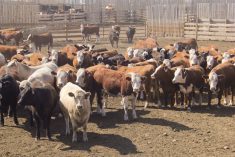Chicago Mercantile Exchange hogs on Friday gained for a third day in a row as fund buying stirred short-covering, traders and analysts said.
Spot October hogs’ discount to the most recent exchange hog index on Tuesday at 96.38 cents per pound motivated buyers (all figures US$). And buy-stops were triggered after nearby CME hog contracts broke through moving average resistance levels.
Spot October finished at 91.85 cents/lb., up 0.55 cent and slightly below the 10-day moving average of 91.92 cents.
Most-actively traded December closed 0.85 cent/lb. higher at 87.625 cents. It ended above the point at which the 10-day and 20-day moving averages converged at 87.33 cents.
Read Also

U.S. livestock: Feeder cattle hit contract highs on tight supply
Chicago | Reuters – All Chicago Mercantile Exchange feeder cattle futures and most live cattle futures hit contract highs on…
Futures rose in the face of a seasonal increase in supplies. More hogs could pressure cash hog and wholesale pork values.
Packers on Friday processed an estimated 418,000 hogs, up 4,000 from last week. The industry is expected to slaughter about 56,000 head on Saturday, according to analytical market research firm Urner Barry.
Terminal and direct cash hog prices on Friday were steady to weak, industry sources and hog buyers said.
Tyson Foods, the largest U.S. meat processor, plans to use an alternative system to calculate how much it should pay hog producers after the U.S. Department of Agriculture suspended market data following the partial shutdown of the federal government.
“The lack of USDA market information can make the market go into areas and zones that make no sense,” said Linn Group analyst John Ginzel.
Futures investors worry that bullish traders might liquidate their massive long positions if the U.S. government’s closure extends past the Oct. 17 deadline for raising the U.S. debt ceiling.
Traders bought deferred hog contracts with the view that hog farmers can decrease production if corn prices move higher.
Cattle up on tight supply ideas
CME live cattle finished higher in anticipation of tighter supplies in the weeks ahead, traders said.
October closed up 0.625 cent/lb. at 128.05 cents. December finished at 132.425 cents, 0.65 cent higher, after peaking at its highest level in nearly eight months.
The October contract has accounted for this week’s cash cattle trade and traders look for fewer cattle ahead, U.S. Commodities analyst Don Roose said.
Cash cattle in the U.S. Plains traded at $125 to $126 per hundredweight (cwt), steady to down $1 compared with last week, feedlot sources said.
Roose said beef demand should improve as cuts more associated with cooking indoors tend to help drive up wholesale beef values.
Urner Barry quoted Friday’s wholesale choice beef price, or cutout, down two cents/cwt from Thursday at $192.31. The select price rose 50 cents to $176.73.
Packers this week resisted spending more than necessary for supplies while grappling with poor margins.
Estimated margins for U.S. beef packers on Friday were a negative $41.95 per head, compared with a negative $40.90 on Thursday and a negative $7.85 a week ago, according to HedgersEdge.com.
Traders await the first notice day for deliveries on Monday. CME on Wednesday said those deliveries against October futures will not be affected by the partial government closure.
CME live cattle buying pulled up feeder cattle contracts.
October feeder cattle ended up 0.35 cent/lb. at 164.45 cents. November settled at 165.95 cents, 0.325 cent higher.
— Theopolis Waters reports on livestock futures markets for Reuters from Chicago.















